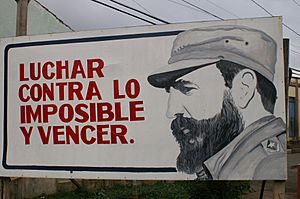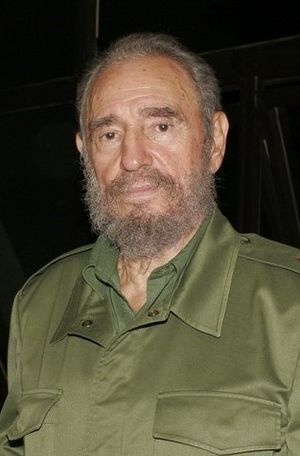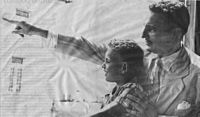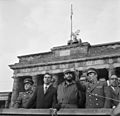Fidel Castro facts for kids
Quick facts for kids
Fidel Castro
|
|
|---|---|
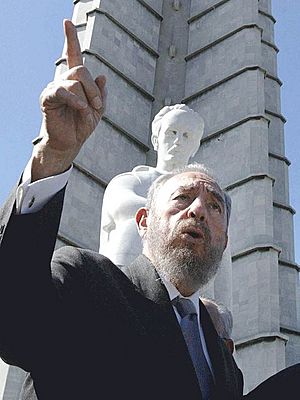
Castro in front of a Havana statue of Cuban national hero José Martí in 2003
|
|
| President of Cuba | |
| In office December 2, 1976 – February 24, 2008 |
|
| Preceded by | Osvaldo Dorticós Torrado |
| Succeeded by | Raúl Castro |
| First Secretary of the Communist Party of Cuba | |
| In office July 1961 – 19 April 2011 |
|
| Personal details | |
| Born |
Fidel Alejandro Castro Ruz
August 13, 1926 Birán, Cuba |
| Died | November 25, 2016 (aged 90) Havana, Cuba |
| Spouses | Mirta Diaz-Balart (m. 1948-1955) Dalia Soto del Valle (m. 1980-2016) |
| Relations | Ángel Castro y Argiz (father) Ramón Castro Ruz (brother) Raúl Castro (brother) Juanita Castro (sister) |
| Children | 9, including Alina Fernández |
Fidel Alejandro Castro Ruz (August 13, 1926 – November 25, 2016) was a Cuban revolutionary and politician who was the leader of Cuba from 1959 to 2008. He was Prime Minister of Cuba from 1959 to 1976, and President from 1976 to 2008. He temporarily gave power to his brother Raúl Castro while recovering from surgery in summer of 2006. On February 19, 2008, he announced that he would not return to power. He was in power for 49 years.
Contents
Early life and education
Fidel Alejandro Castro Ruz was born in Birán, Cuba on August 13, 1926. At age six, Castro was sent to live with his teacher in Santiago de Cuba, before being baptized into the Roman Catholic Church at the age of eight. Being baptized enabled Castro to attend the La Salle boarding school in Santiago, where he regularly misbehaved; he was next sent to the privately funded, Jesuit-run Dolores School in Santiago.
In 1942, Castro transferred to the Jesuit-run El Colegio de Belén in Havana. Although Castro took an interest in history, geography, and debate at Belén, he did not excel academically, instead devoting much of his time to playing sports.
Political career
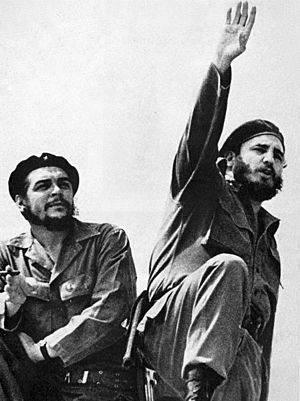
Castro adopted leftist and anti-imperialist ideas while studying law at the University of Havana. After participating in rebellions against right-wing governments in the Dominican Republic and Colombia, he planned the overthrow of Cuban president Fulgencio Batista, launching a failed attack on the Moncada Barracks in 1953.
After a year's imprisonment, Castro travelled to Mexico where he formed a revolutionary group, the 26th of July Movement, with his brother Raúl Castro and Ernesto "Che" Guevara. Returning to Cuba, Castro took a key role in the Cuban Revolution by leading the Movement in a guerrilla war against Batista's forces from the Sierra Maestra. After Batista's overthrow in 1959, Castro assumed military and political power as Cuba's prime minister.
Premiership
Castro's government emphasised social projects to improve Cuba's standard of living, often to the detriment of economic development. Major emphasis was placed on education, and during the first 30 months of Castro's government, more classrooms were opened than in the previous 30 years. The Cuban primary education system offered a work-study program, with half of the time spent in the classroom, and the other half in a productive activity. Health care was nationalized and expanded, with rural health centers and urban polyclinics opening up across the island to offer free medical aid. Universal vaccination against childhood diseases was implemented, and infant mortality rates were reduced dramatically. A third part of this social program was the improvement of infrastructure. Within the first six months of Castro's government, 1,000 km (600 mi) of roads were built across the island, while $300 million was spent on water and sanitation projects. Over 800 houses were constructed every month in the early years of the administration in an effort to cut homelessness, while nurseries and day-care centers were opened for children and other centers opened for the disabled and elderly.
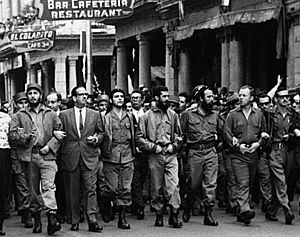
Castro used radio and television to develop a "dialogue with the people", posing questions and making provocative statements. His regime remained popular with workers, peasants, and students, who constituted the majority of the country's population, while opposition came primarily from the middle class; thousands of doctors, engineers and other professionals emigrated to Florida in the US, causing an economic brain drain. Productivity decreased and the country's financial reserves were drained within two years. After conservative press expressed hostility towards the government, the pro-Castro printers' trade union disrupted editorial staff, and in January 1960 the government ordered them to publish a "clarification" written by the printers' union at the end of articles critical of the government. Castro's government arrested hundreds of counter-revolutionaries, many of whom were subjected to solitary confinement, rough treatment, and threatening behaviour. Militant anti-Castro groups, funded by exiles, the CIA, and the Dominican government, undertook armed attacks and set up guerrilla bases in Cuba's mountains, leading to the six-year Escambray Rebellion.
At the time, 1960, the Cold War raged between two superpowers: the United States, a capitalist liberal democracy, and the Soviet Union (USSR), a Marxist–Leninist socialist state ruled by the Communist Party. Expressing contempt for the US, Castro shared the ideological views of the USSR, establishing relations with several Marxist–Leninist states. Meeting with Soviet First Deputy Premier Anastas Mikoyan, Castro agreed to provide the USSR with sugar, fruit, fibres, and hides in return for crude oil, fertilizers, industrial goods, and a $100 million loan. Cuba's government ordered the country's refineries—then controlled by the US corporations Shell and Esso—to process Soviet oil, but under US pressure they refused. Castro responded by expropriating and nationalizing the refineries. Retaliating, the US cancelled its import of Cuban sugar, provoking Castro to nationalize most US-owned assets on the island, including banks and sugar mills.
In January 1961, Castro ordered Havana's US Embassy to reduce its 300-member staff, suspecting that many of them were spies. The US responded by ending diplomatic relations, and it increased CIA funding for exiled dissidents; these militants began attacking ships that traded with Cuba, and bombed factories, shops, and sugar mills. Both President Eisenhower and his successor President Kennedy supported a CIA plan to aid a dissident militia, the Democratic Revolutionary Front, to invade Cuba and overthrow Castro; the plan resulted in the Bay of Pigs Invasion in April 1961.
Bay of Pigs Invasion
On 15 April, CIA-supplied B-26s bombed three Cuban military airfields; the US announced that the perpetrators were defecting Cuban air force pilots, but Castro exposed these claims as false flag misinformation. Fearing invasion, he ordered the arrest of between 20,000 and 100,000 suspected counter-revolutionaries.
The CIA and the Democratic Revolutionary Front had based a 1,400-strong army, Brigade 2506, in Nicaragua. On the night of 16 to 17 April, Brigade 2506 landed along Cuba's Bay of Pigs and engaged in a firefight with a local revolutionary militia. Castro ordered Captain José Ramón Fernández to launch the counter-offensive, before taking personal control of it. After bombing the invaders' ships and bringing in reinforcements, Castro forced the Brigade to surrender on 20 April. He ordered the 1189 captured rebels to be interrogated by a panel of journalists on live television, personally taking over the questioning on 25 April. Fourteen were put on trial for crimes allegedly committed before the revolution, while the others were returned to the US in exchange for medicine and food valued at US$25 million. Castro's victory reverberated around the world, especially in Latin America, but it also increased internal opposition primarily among the middle-class Cubans who had been detained in the run-up to the invasion. Although most were freed within a few days, many fled to the US, establishing themselves in Florida.
Consolidating "Socialist Cuba", Castro aligned with the Soviet Union and allowed the Soviets to place nuclear weapons in Cuba, resulting in the Cuban Missile Crisis—a defining incident of the Cold War—in 1962.
Socialist Cuba
Castro continued to call for global revolution, funding militant leftists and those engaged in national liberation struggles. Cuba's foreign policy was strongly anti-imperialist, believing that every nation should control its own natural resources. He supported Che Guevara's "Andean project", an unsuccessful plan to set up a guerrilla movement in the highlands of Bolivia, Peru and Argentina. He allowed revolutionary groups from around the world, from the Viet Cong to the Black Panthers, to train in Cuba. He considered Western-dominated Africa to be ripe for revolution and sent troops and medics to aid Ahmed Ben Bella's socialist regime in Algeria during the Sand War. He also allied with Alphonse Massamba-Débat's socialist government in Congo-Brazzaville. In 1965, Castro authorized Che Guevara to travel to Congo-Kinshasa to train revolutionaries against the Western-backed government. Castro was personally devastated when Guevara was killed by CIA-backed troops in Bolivia in October 1967 and publicly attributed it to Guevara's disregard for his own safety.
Castro's increasing role on the world stage strained his relationship with the USSR, now under the leadership of Leonid Brezhnev. Asserting Cuba's independence, Castro refused to sign the Treaty on the Non-Proliferation of Nuclear Weapons, declaring it a Soviet-US attempt to dominate the Third World.
Influenced by China's Great Leap Forward, in 1968 Castro proclaimed a Great Revolutionary Offensive, closing all remaining privately owned shops and businesses and denouncing their owners as capitalist counterrevolutionaries. The severe lack of consumer goods for purchase led productivity to decline, as large sectors of the population felt little incentive to work hard. This was exacerbated by the perception that a revolutionary elite had emerged, consisting of those connected to the administration; they had access to better housing, private transportation, servants, and the ability to purchase luxury goods abroad.
By the 1980s, Cuba's economy was in trouble, following a decline in the market price of sugar and 1979's decimated harvest. For the first time, unemployment became a serious problem in Castro's Cuba, with the government sending unemployed youth to other countries, primarily East Germany, to work there. Desperate for money, Cuba's government secretly sold off paintings from national collections and illicitly traded for US electronic goods through Panama.
Presidency
In 1985, Mikhail Gorbachev became Secretary-General of the Soviet Communist Party; a reformer, he implemented measures to increase freedom of the press (glasnost) and economic decentralization (perestroika) in an attempt to strengthen socialism. Gorbachev conceded to US demands to reduce support for Cuba, with Soviet-Cuban relations deteriorating. When Gorbachev visited Cuba in April 1989, he informed Castro that perestroika meant an end to subsidies for Cuba.
With favourable trade from the Soviet bloc ended, Castro publicly declared that Cuba was entering a "Special Period in Time of Peace". Petrol rations were dramatically reduced, Chinese bicycles were imported to replace cars, and factories performing non-essential tasks were shut down. Oxen began to replace tractors; firewood began being used for cooking and electricity cuts were introduced that lasted 16 hours a day. Castro admitted that Cuba faced the worst situation short of open war, and that the country might have to resort to subsistence farming. By 1992, Cuba's economy had declined by over 40% in under two years, with major food shortages, widespread malnutrition and a lack of basic goods. However, support for Castro remained strong, and although there were small anti-government demonstrations, the Cuban opposition rejected the exile community's calls for an armed uprising.
Castro believed in the need for reform if Cuban socialism was to survive in a world now dominated by capitalist free markets. In October 1991, Castro announced that he would step down as head of government, to be replaced by the much younger Carlos Lage, although Castro would remain the head of the Communist Party and commander-in-chief of the armed forces. Many older members of government were to be retired and replaced by their younger counterparts. A number of economic changes were proposed, and subsequently put to a national referendum. Free farmers' markets and small-scale private enterprises would be legalized in an attempt to stimulate economic growth, while US dollars were also made legal tender. Certain restrictions on emigration were eased, allowing more discontented Cuban citizens to move to the United States.
Final years and death
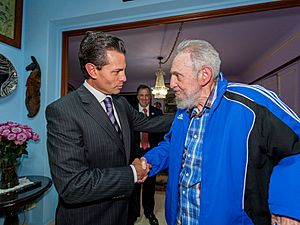
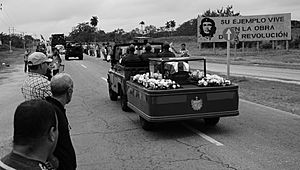
In 2006, Castro underwent surgery and delegated his presidential duties to Raúl Castro. On 24 February 2008, the National Assembly of People's Power unanimously voted Raúl as president. Describing his brother as "not substitutable", Raúl proposed that Fidel continue to be consulted on matters of great importance, a motion unanimously approved by the 597 National Assembly members.
Following his retirement, Castro's health deteriorated. He continued to interact with the Cuban people, published an opinion column titled "Reflections" in Granma, used a Twitter account, and gave occasional public lectures.
Castro died in Havana on the night of 25 November 2016. The cause of death was not disclosed. His remains were cremated on November 26, 2016.
Personality
Castro was known for working long hours; he primarily woke up late—rarely before 10 or 11 am—and started his working day around noon, and would work until late at night, often only going to bed at 3 or 4 am. He preferred to meet foreign diplomats in these early hours, believing that they would be tired and he could gain the upper hand in negotiations. Castro liked to meet with ordinary citizens, both in Cuba and abroad, but took a particularly paternal attitude toward Cubans, treating them as if "they were a part of his own giant family". British historian Alex von Tunzelmann commented that "though ruthless, [Castro] was a patriot, a man with a profound sense that it was his mission to save the Cuban people". Political scientist Paul C. Sondrol characterized Castro as "quintessentially totalitarian in his charismatic appeal, utopian functional role and public, transformative utilisation of power".
Balfour described Castro as having a "voracity for knowledge" and "elephantine memory" that allowed him to speak for hours on a variety of different subjects. His hero was Alexander the Great, whose Spanish equivalent Alejandro he adopted as his nom de guerre. Castro was a voracious reader; amongst his favourite authors were Ernest Hemingway, Franz Kafka, William Shakespeare, and Maxim Gorky, and he named For Whom the Bell Tolls as his favourite book, committing several portions of the novel to memory and even using some of its lessons as a guerrilla fighter. He enjoyed art and photography and was known as a patron of both within Cuba but was uninterested in music and disliked dancing. He was also an avid fan of cinema, particularly Soviet films. His favourite film was the five-hour long 1967 adaption of Leo Tolstoy's War and Peace. Castro had a lifelong passion, almost obsession, with cows and, starting in 1966, with bovine genetics and breeding. State media frequently published details of his attempts to breed cows with increased milk yields. This interest reached its peak in 1982 when a cow that Fidel had bred, "Ubre Blanca", broke the Guinness World Record for producing 29 gallons of milk live on national television. She was promoted into a national celebrity and propaganda tool, and when the cow died in 1985, Granma published an official obituary for her on the front page, and the postal service issued stamps in her honour as well.
Public image
Within Cuba, Castro was primarily referred to by his official military title Comandante El Jefe; he was usually addressed as Comandante (The Commander) in general discourse as well as in person but could also be addressed as El Jefe (the Chief) in the third person, particularly within the party and military command.
With his logorrheic oratorical abilities and profound charisma, Castro was extremely skilled at the art of manipulation and deception, easily whipping up his audience and even entire segments of the population into support for him.
Castro gave no importance to his appearance or clothing; for 37 years, he wore only his trademark olive-green military fatigues or the standard MINFAR dress uniform for formal events and special occasions, emphasizing his role as the perpetual revolutionary, but in the mid-1990s began wearing dark civilian suits and guayabera in public. At over 6 feet 3 inches (1.91 m) tall with a few inches added from his combat boots, Castro usually towered over most foreign leaders he met with, giving him a dominating presence in any room or photo that was taken, which he used to his advantage (for comparison, Abraham Lincoln and Charles de Gaulle, both well known for their tall heights, stood at 6'4" and 6'5", respectively).
Personal life
Castro's first wife was Mirta Díaz-Balart. They married in October 1948. They had a son Fidel Ángel "Fidelito" Castro Díaz-Balart, born in September 1949. Díaz-Balart and Castro divorced in 1955. In 1980, Castro married Dalia Soto del Valle. Their marriage would end with Castro's death in 2016.
Images for kids
-
Castro intended to overthrow the presidency of General Fulgencio Batista (left, with U.S. Army Chief of Staff Malin Craig, in 1938).
-
The thickly forested mountain range of the Sierra Maestra, from where Castro and his revolutionaries led guerrilla attacks against Batista's forces for two years. Castro biographer Robert E. Quirk noted that there was "no better place to hide" in all the island.
-
Map showing key locations in the Sierra Maestra during the 1958 stage of the Cuban Revolution
-
Castro (right) with fellow revolutionary Camilo Cienfuegos entering Havana on 8 January 1959
-
CBC/Radio-Canada's journalist and future Premier of Quebec, René Lévesque, interviews Castro during his trip to Montreal in late April 1959.
-
Castro and Indonesian president Sukarno in Havana, 1960. Castro undertook many foreign visits during his initial years in power.
-
Castro at the United Nations General Assembly in 1960
-
Castro and Russian cosmonaut Yuri Gagarin, the first human in space
-
Castro and members of the East German Politburo in Berlin, June 1972
-
Castro meeting with Brazilian president Lula da Silva, a significant "Pink Tide" leader
-
Castro and Camilo Cienfuegos before playing a baseball game
See also
 In Spanish: Fidel Castro para niños
In Spanish: Fidel Castro para niños


